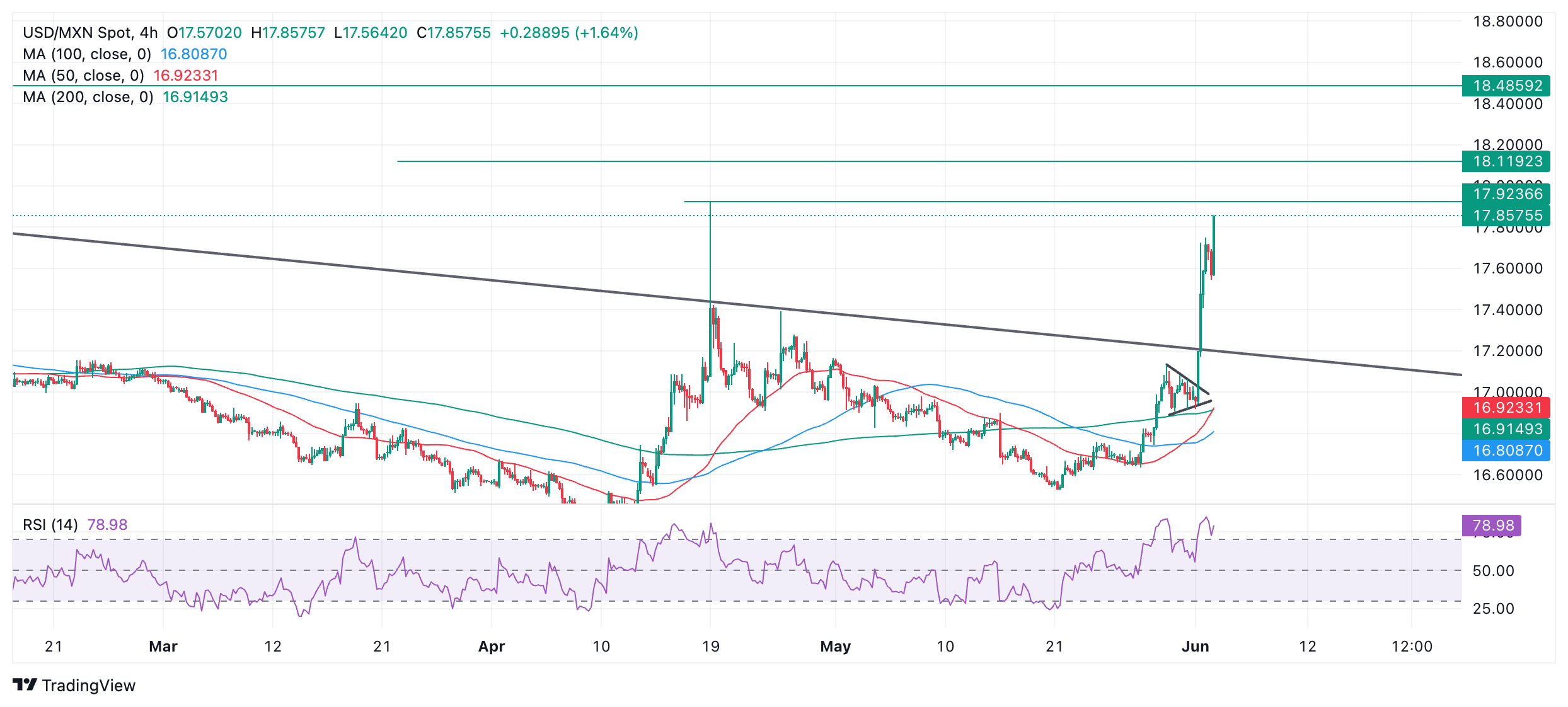- The Mexican Peso continues to fall after plummeting over 4% in key pairs on Monday.
- The possibility of the left-leaning Morena party winning a supermajority sparks fears among investors.
- USD/MXN breaks above a key long-term trendline, transforming the technical picture for the pair.
The Mexican Peso (MXN) is resuming its downtrend on Tuesday following an over 4% decline in its key pairs on Monday. The Peso went into freefall after early indications showed President-elect Claudia Sheinbaum and her Morena party were heading for a landslide victory in the Mexican presidential and congressional elections held on Sunday.
USD/MXN is exchanging hands at 17.79 at the time of writing, EUR/MXN is trading at 19.34 and GBP/MXN at 22.73.
Mexican Peso weakens on fears of a Morena party supermajority
The Mexican Peso plummeted on Monday after a quick count by the National Electoral Institute showed Claudia Sheinbaum leading with at least 59% of the vote in the presidential elections, and her Morena party poised to possibly clinch super majorities in both houses of the Mexican legislature, according to Aljazeera News. The official results will be published after the votes are counted between June 5-8.
The Mexican Peso weakened significantly after investors became nervous Sheinbaum’s Morena party could win super majorities – defined as a majority of two thirds – in both the Congress and the Senate. This would enable them to enact proposed reforms to the Mexican constitution, such as the election of the judiciary by popular vote and the preferential treatment of state-owned energy companies over private corporations. Critics argue such changes could be anti-democratic and market unfriendly.
According to estimates by Bloomberg Economics, Morena will probably win a super majority in Congress but fall four-seats short of one in the Senate.
“Although that doesn’t immediately allow Sheinbaum to make changes to the constitution that have eluded [current President] Andres Manuel Lopez Obrador, it leaves her in the position to negotiate with just a few senators to pass key reforms,” said Bloomberg News’ Economy and Government reporter Alex Vasquez.
Yet not all of Sheinbaum’s policies will necessarily hurt the Mexican Peso. Her pledge to increase the minimum wage by around 11%, better welfare benefits and government-led investment could increase consumer spending and economic growth, forcing the Banco de México (Banxico) to maintain high interest rates, according to Kimberley Sperrfechter, Emerging Markets Economist at Capital Economics.
Since relatively high interest rates attract more foreign capital inflows, the Peso could remain well-supported despite investor fears.
Technical Analysis: USD/MXN breaks decisively above major trendline
USD/MXN – or the number of Pesos that can be bought with one US Dollar – breaks above a long-term trendline, marking a major shift in the outlook for the pair and probably reversing the intermediate-term downtrend to an uptrend.
With both the short and intermediate trends bullish, the odds favor more upside over those time frames (up to six months).
USD/MXN 4-hour Chart
Further upside could see USD/MXN reach the April highs at around 17.92, followed by resistance at 18.12 (100-week Simple Moving Average) and then 18.49 (October 2023 high).
The long-term trend is probably still bearish, however, suggesting a risk of a reversal lower if the uptrend runs out of steam. There are no signs of that happening yet from price action, however, which remains resolutely bullish.
Banxico FAQs
The Bank of Mexico, also known as Banxico, is the country’s central bank. Its mission is to preserve the value of Mexico’s currency, the Mexican Peso (MXN), and to set the monetary policy. To this end, its main objective is to maintain low and stable inflation within target levels – at or close to its target of 3%, the midpoint in a tolerance band of between 2% and 4%.
The main tool of the Banxico to guide monetary policy is by setting interest rates. When inflation is above target, the bank will attempt to tame it by raising rates, making it more expensive for households and businesses to borrow money and thus cooling the economy. Higher interest rates are generally positive for the Mexican Peso (MXN) as they lead to higher yields, making the country a more attractive place for investors. On the contrary, lower interest rates tend to weaken MXN. The rate differential with the USD, or how the Banxico is expected to set interest rates compared with the US Federal Reserve (Fed), is a key factor.
Banxico meets eight times a year, and its monetary policy is greatly influenced by decisions of the US Federal Reserve (Fed). Therefore, the central bank’s decision-making committee usually gathers a week after the Fed. In doing so, Banxico reacts and sometimes anticipates monetary policy measures set by the Federal Reserve. For example, after the Covid-19 pandemic, before the Fed raised rates, Banxico did it first in an attempt to diminish the chances of a substantial depreciation of the Mexican Peso (MXN) and to prevent capital outflows that could destabilize the country.
Information on these pages contains forward-looking statements that involve risks and uncertainties. Markets and instruments profiled on this page are for informational purposes only and should not in any way come across as a recommendation to buy or sell in these assets. You should do your own thorough research before making any investment decisions. FXStreet does not in any way guarantee that this information is free from mistakes, errors, or material misstatements. It also does not guarantee that this information is of a timely nature. Investing in Open Markets involves a great deal of risk, including the loss of all or a portion of your investment, as well as emotional distress. All risks, losses and costs associated with investing, including total loss of principal, are your responsibility. The views and opinions expressed in this article are those of the authors and do not necessarily reflect the official policy or position of FXStreet nor its advertisers. The author will not be held responsible for information that is found at the end of links posted on this page.
If not otherwise explicitly mentioned in the body of the article, at the time of writing, the author has no position in any stock mentioned in this article and no business relationship with any company mentioned. The author has not received compensation for writing this article, other than from FXStreet.
FXStreet and the author do not provide personalized recommendations. The author makes no representations as to the accuracy, completeness, or suitability of this information. FXStreet and the author will not be liable for any errors, omissions or any losses, injuries or damages arising from this information and its display or use. Errors and omissions excepted.
The author and FXStreet are not registered investment advisors and nothing in this article is intended to be investment advice.
Recommended content
Editors’ Picks

EUR/USD extends slide toward 1.0300, touches new two-year low
EUR/USD stays under bearish pressure and trades at its lowest level since December 2022 below 1.0350 on Thursday. The US Dollar benefits from the risk-averse market atmosphere and the upbeat Jobless Claims data, causing the pair to stretch lower.

GBP/USD slumps to multi-month lows near 1.2400 on broad USD strength
Following an earlier recovery attempt, GBP/USD reversed its direction and declined to its weakest level in nearly eight months near 1.2400. The renewed US Dollar (USD) strength on worsening risk mood weighs on the pair as trading conditions normalize after the New Year break.

Gold benefits from risk aversion, climbs above $2,640
Gold gathers recovery momentum and trades at a two-week-high above $2,640 in the early American session on Thursday. The precious metal benefits from the sour market mood and the pullback seen in the US Treasury bond yields.

XRP rockets 11% as Bitcoin starts New Year with bullish bang
Crypto majors zoomed higher in the past 24 hours as the market entered a widely expected bullish year, with Bitcoin inching above $95,000 to shake off losses from last week. XRP surged 11% to lead growth among majors as of Thursday, led by $1.3 billion worth of trading volumes on Korea-focused exchange UpBit.

Three Fundamentals: Year-end flows, Jobless Claims and ISM Manufacturing PMI stand out Premium
Money managers may adjust their portfolios ahead of the year-end. Weekly US Jobless Claims serve as the first meaningful release in 2025. The ISM Manufacturing PMI provides an initial indication ahead of Nonfarm Payrolls.

Best Forex Brokers with Low Spreads
VERIFIED Low spreads are crucial for reducing trading costs. Explore top Forex brokers offering competitive spreads and high leverage. Compare options for EUR/USD, GBP/USD, USD/JPY, and Gold.
